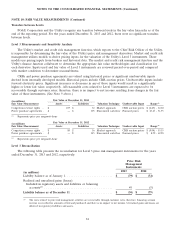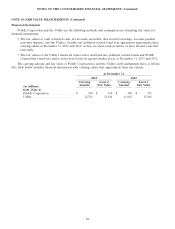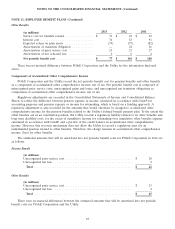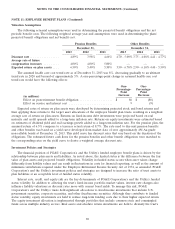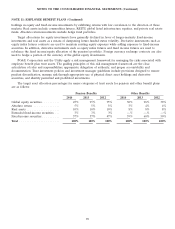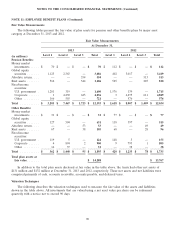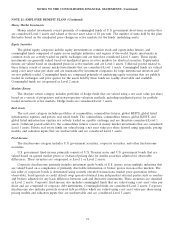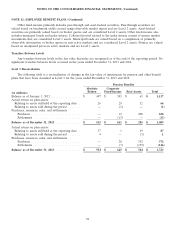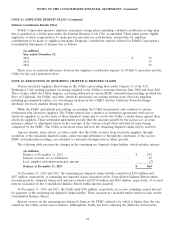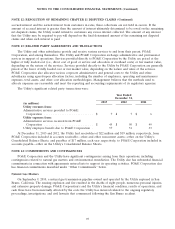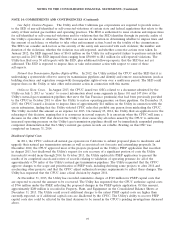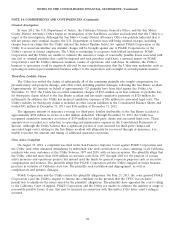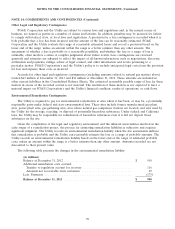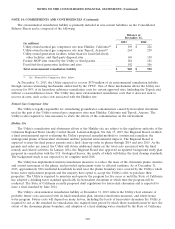PG&E 2013 Annual Report Download - page 97
Download and view the complete annual report
Please find page 97 of the 2013 PG&E annual report below. You can navigate through the pages in the report by either clicking on the pages listed below, or by using the keyword search tool below to find specific information within the annual report.NOTES TO THE CONSOLIDATED FINANCIAL STATEMENTS (Continued)
NOTE 11: EMPLOYEE BENEFIT PLANS (Continued)
Money Market Investments
Money market investments consist primarily of commingled funds of U.S. government short-term securities that
are considered Level 1 assets and valued at the net asset value of $1 per unit. The number of units held by the plan
fluctuates based on the unadjusted price changes in active markets for the funds’ underlying assets.
Equity Securities
The global equity categories include equity investments in common stock and equity-index futures, and
commingled funds comprised of equity across multiple industries and regions of the world. Equity investments in
common stock are actively traded on public exchanges and are therefore considered Level 1 assets. These equity
investments are generally valued based on unadjusted prices in active markets for identical securities. Equity-index
futures are valued based on unadjusted prices in active markets and are Level 1 assets. Collateral posted related to
these futures consist of money market investments that are considered Level 1 assets. Commingled funds are valued
using a net asset value per share and are maintained by investment companies for large institutional investors and
are not publicly traded. Commingled funds are comprised primarily of underlying equity securities that are publicly
traded on exchanges, and price quotes for the assets held by these funds are readily observable and available.
Commingled funds are categorized as Level 2 assets.
Absolute Return
The absolute return category includes portfolios of hedge funds that are valued using a net asset value per share
based on a variety of proprietary and non-proprietary valuation methods, including unadjusted prices for publicly-
traded securities in active markets. Hedge funds are considered Level 3 assets.
Real Assets
The real asset category includes portfolios of commodities, commodities futures, global REITS, global listed
infrastructure equities, and private real estate funds. The commodities, commodities futures, global REITS, and
global listed infrastructure equities are actively traded on a public exchange and are therefore considered Level 1
assets. Collateral posted related to the commodities futures consist of money market investments that are considered
Level 1 assets. Private real estate funds are valued using a net asset value per share derived using appraisals, pricing
models, and valuation inputs that are unobservable and are considered Level 3 assets.
Fixed-Income
The fixed-income category includes U.S. government securities, corporate securities, and other fixed-income
securities.
U.S. government fixed-income primarily consists of U.S. Treasury notes and U.S. government bonds that are
valued based on quoted market prices or evaluated pricing data for similar securities adjusted for observable
differences. These securities are categorized as Level 1 or Level 2 assets.
Corporate fixed-income primarily includes investment grade bonds of U.S. issuers across multiple industries that
are valued based on a compilation of primarily observable information or broker quotes in non-active markets. The
fair value of corporate bonds is determined using recently executed transactions, market price quotations (where
observable), bond spreads or credit default swap spreads obtained from independent external parties such as vendors
and brokers adjusted for any basis difference between cash and derivative instruments. These securities are classified
as Level 2 assets. Corporate fixed-income also includes commingled funds that are valued using a net asset value per
share and are comprised of corporate debt instruments. Commingled funds are considered Level 2 assets. Corporate
fixed-income also includes privately secured debt portfolios which are valued using a net asset value per share using
pricing models and valuation inputs that are unobservable and are considered Level 3 assets.
91


